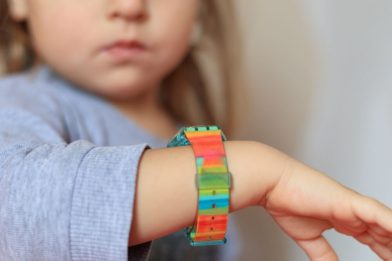Coding for Kids: How to Turn Your Kid Into a Computer Genius?
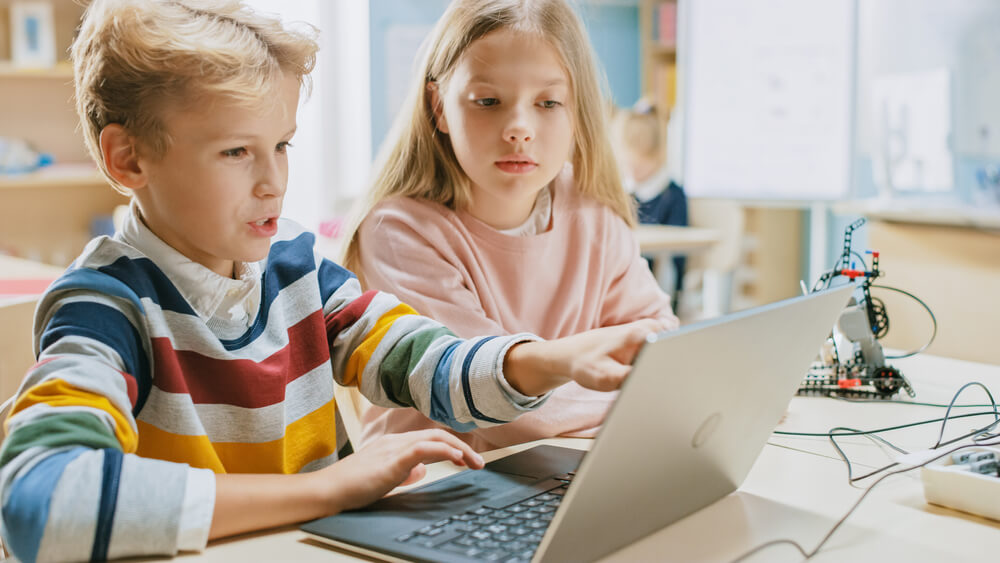
Teaching kids computer programming has become such a necessity for parents and schools in our increasingly digital age. If you’re interested in what all the hype is about, then you may be asking: What is coding for kids, anyway, and should I get my child involved in computer science?
You’ve come to the right place. In this guide to programming for kids, we’ll talk about what coding is, why it’s important, and how to get children interested in learning this contemporary skill. We’ll even identify some of the common indicators that your child will be successful with coding concepts and point out specific resources for getting started.
So, what are you waiting for? Learn more about how coding could transform your child’s future for the better!
Contents:
- What Is Coding?
- At What Age Can a Child Start Coding?
- Signs That Your Kid is Destined to Become a Computer Programmer
- How Can You Get Your Child Interested in Coding?
- How to Teach Coding to Kids?
- FAQs
What Is Coding?

Gorodenkoff/Shutterstock.com
In our technology-driven society, nearly everyone has heard of coding. Do you know what coding actually is, though?
Coding is synonymous with computer programming. It consists of writing scripts in a programming language like Java or Python. Scripts written in these languages communicate instructions for computers. When a script is written correctly, the computer will perform certain tasks.
Sounds difficult, right? In reality, coding or software programming can be simple or complex. Today, it is an essential skill that IT professionals need to develop websites, web applications, mobile apps, games, and more. This is the reason it’s gaining popularity as a concept to teach children.
Is Coding Good for Kids?
There’s no doubt that coding is a professional skill set—and a potentially profitable one at that! But is it appropriate or even feasible to teach coding to kids? Many people think so, including parents and teachers. Since coding is comparable to language, some argue that learning it at a young age is actually preferable.
Let’s look at some of the pros and cons of teaching computer programming skills to youngsters.
Benefits of Coding for Kids
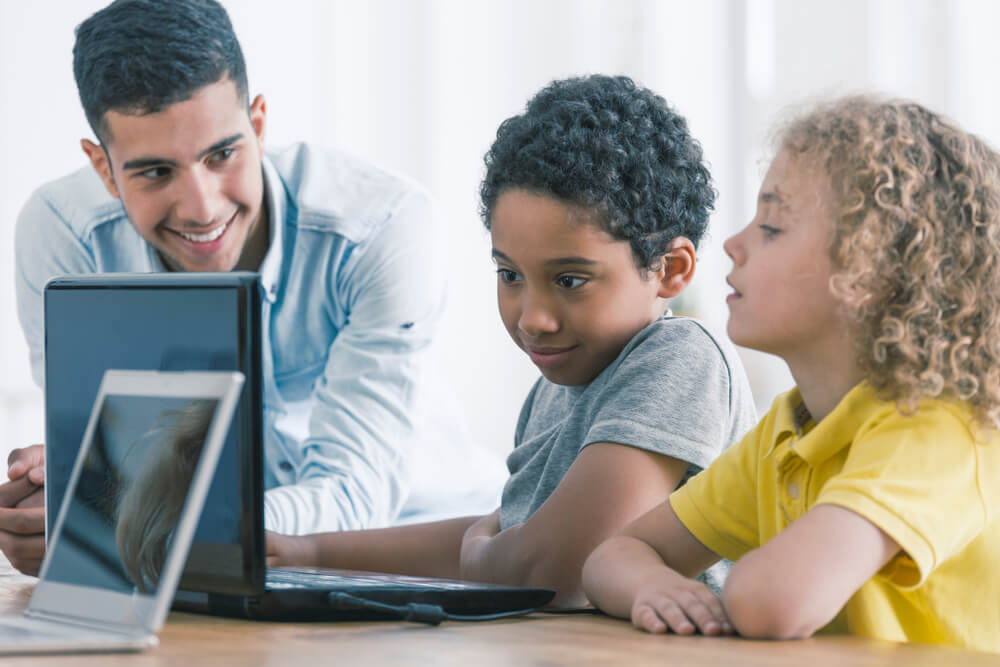
Photographee.eu/Shutterstock.com
Learning virtually anything has its benefits, but there are specific advantages of teaching kids coding concepts and skills. For instance, when kids learn to code, they learn patience, problem-solving skills, creative focus, and confidence. That’s because coding requires a high level of concentration and creativity. It’s not an easy skill to learn, so when kids master it, they gain a sense of pride in their accomplishments.
Plus, coding brings with it certain advantages and opportunities for the future. Children who learn basic coding at an early age may enjoy more success with programming as they get older. This can put them in line for sought-after job opportunities in the tech field and beyond, especially with the rising popularity of Artificial Intelligence and Machine Learning.
Drawbacks of Coding for Kids

Veja/Shutterstock.com
Fortunately, there aren’t many disadvantages to teaching children programming skills. Thus, there are a few risks, but the rewards can be great!
The potential drawbacks of coding for kids are the same as those that confront adults. That is, coding is hard. It’s not something people are typically good at right away. Most people make lots of mistakes early on, and many feel frustrated at first.
We recommend letting your child take the reins when it comes to learning how to code. If they’re interested in programming, encourage them to try it, but don’t force the issue. Let them learn at their own pace.
Provide positive feedback instead of harsh criticism. Just like anything else, coding comes easiest to children who are supported by their parents and caregivers.
Coding: An Investment in Your Child’s Future or Just More Pressure?
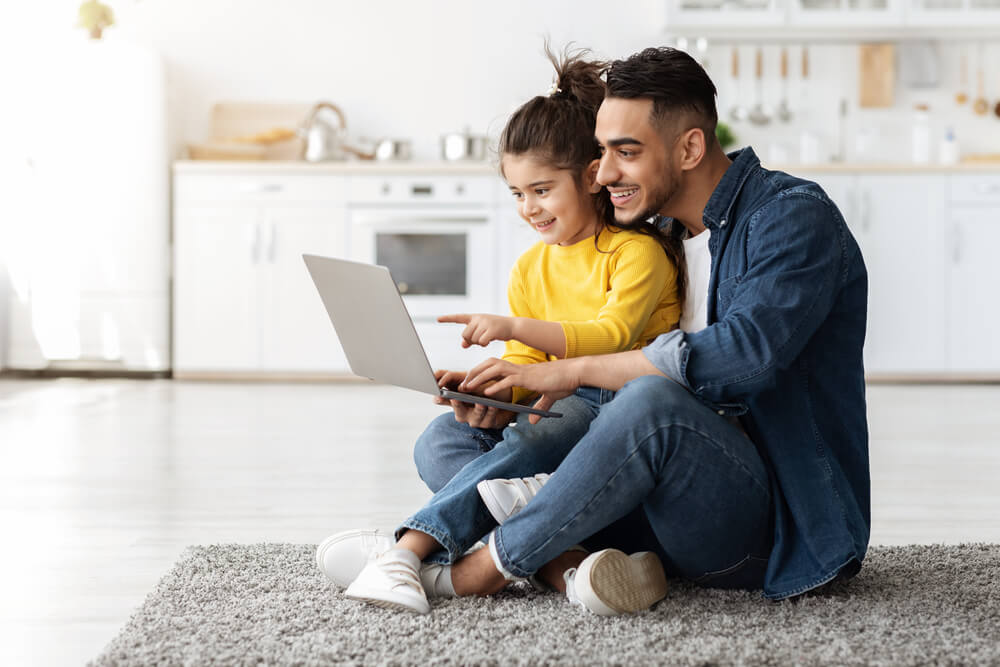
Prostock-studio/Shutterstock.com
There’s already a lot of pressure on kids today, even younger ones. As early as elementary school, children are required to meet certain benchmarks on standardized tests in order to be promoted to the next grade. The pressure to succeed in academics only increases as kids get older, with strict graduation requirements. Think high school GPA and ACT scores, for example.
All of this begs the question: Is it absolutely necessary to teach kids to code? The answer, of course, is no. But is it an investment in your child’s future? That is another issue entirely.
The truth is, coding and computer science are becoming more and more popular amongst hiring managers, and not just in the technology sector. As computer programming permeates nearly every aspect of our modern society, it’s a safe bet that coding will continue to be in demand in the future.
Therefore, while coding is not yet an essential skill, it could be in the coming decades. For now, it’s up to you to decide if coding classes are a valuable use of your child’s time and energy.
At What Age Can a Child Start Coding?
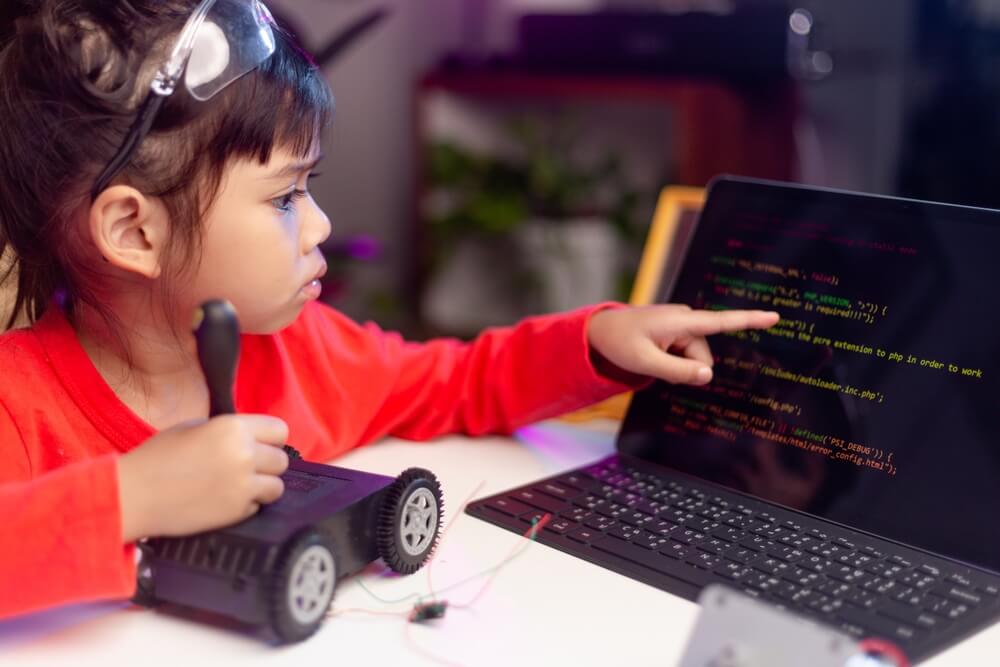
FAMILY STOCK/Shutterstock.com
If you’ve decided that teaching your child to code is a worthwhile endeavor, then the next question to ask is: When is the appropriate time to begin coding classes?
There is some debate about when a child can start learning to code. Most agree, though, that kids are ready to learn basic coding skills between the ages of five and six.
If this seems early to you, remember that this is around the same age kids begin to learn the building blocks of their native language. Plus, experts advise that it’s just as easy for a child to learn two languages simultaneously as it is for them to learn one. This changes as children get older, of course.
Still, it’s possible for kids to master coding as preteens and teenagers as well. Just because they’re late to the game doesn’t mean they can’t win. If your child expresses a desire to learn programming at any age, respond with massive amounts of encouragement!
Signs That Your Kid is Destined to Become a Computer Programmer
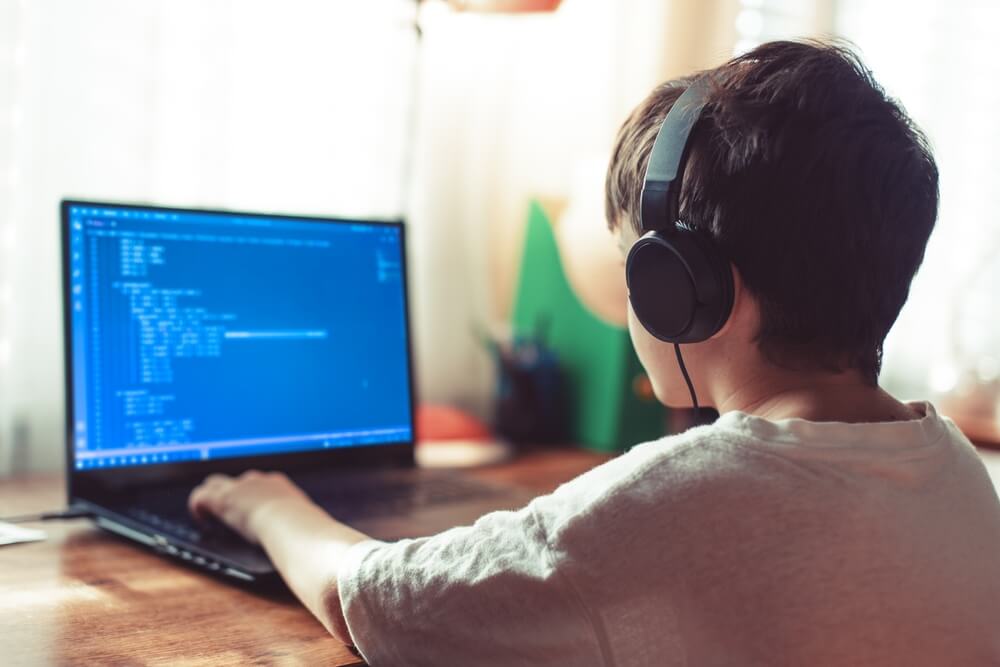
sakkmesterke/Shutterstock.com
Teaching your kid to code early may have you thinking your child could be the next Steve Jobs. After all, when your little one is obsessed with all things technology-related, it’s easy to envision a future for them as a computer programmer. You may even have expectations of them transforming into a computer genius overnight!
Let’s get some perspective, though. An interest in computers and tech toys is a good sign, but there are other indicators to look for, too.
Problem-Solving
For example, is your child a natural problem-solver? Does he or she tend to think logically and look for solutions when obstacles arise? Problem-solving is an essential skill for coders, especially when dealing with conditional statements in code, and it’s one to look for if you think your kid might have a future in programming.
Creativity
Is your child a creative machine spewing innovative ideas everywhere you turn? Creativity is another critical skill for coding, but it may seem counterintuitive. It’s tempting to think of creativity as the opposite of logic, but both skills are necessary for successful coding. Of course, some coding projects, like building a game or app, require higher levels of creativity than others.
Independence
Are you amazed at how often your child figures things out for themselves? Independence is another good sign that your child could be a successful coder or programmer. Much of coding is self-taught, even for kids who attend classes for programming. Children need to be self-driven and capable of learning independently in order to succeed in this discipline.
It’s ok if your little one doesn’t display strengths in all of these areas. After all, they are still growing and learning. They can still master coding so long as they have the desire and resources to do so!
How Can You Get Your Child Interested in Coding?

Hananeko_Studio/Shutterstock.com
Even children who show all the signs of becoming successful with coding will sometimes need a nudge in the right direction. Far and away the best method of piquing a child’s interest in programming is to present it as a fun activity, not a task to be completed.
Fortunately, most children see technology and fun as two sides of the same coin. Presenting them with the opportunity to build something of their own using technology is often enough to get kids excited about coding.
On the other hand, not all children are comfortable with computers and mobile apps. If this sounds familiar, then you may want to start with something more basic, like a board game or toy that promotes logical thinking. Examples of low-tech or no-tech coding tools for children include WowWee Elmoji, Code-a-Pillar, Cozmo Coding Toy, and ThinkFun Gravity Maze Marble Run Logic Game.
How to Teach Coding to Kids?

Gorodenkoff/Shutterstock.com
Once your child has expressed interest in coding, the next step is to figure out how to go about teaching them. So, what is the best way to teach coding to kids? It’s a good question! The answer is complex, though. That’s because what works for one kid may not work for another, and vice versa.
Plus, there’s the child’s age to consider. When you have to teach kids programming, the ideal instructional method will inevitably vary depending on whether you’re working with toddlers and preschoolers or preteens and teenagers.
How to Start Coding: First Steps
For young children in particular, the best approach to take in the beginning is to start small. Begin by introducing them to a visual programming language, sometimes referred to as visual block programming. This method of visual coding allows kids to code without using a text-based language.
In visual programming, children can simply rearrange objects using blocks and arrows. Popular visual programming systems include Blockly and Scratch.
Another common way for kids to learn coding is through games like Minecraft, especially Minecraft Redstone, which teaches them programming through interactive play and gaming.
These complete visual programming systems allow kids to experiment with coding without the crippling frustration that often comes alongside text-based programming. Using block-based coding, kids can focus on learning the basics without memorizing a bunch of different commands. It’s easy and fun!
Methods and Programs for Teaching Coding to Children
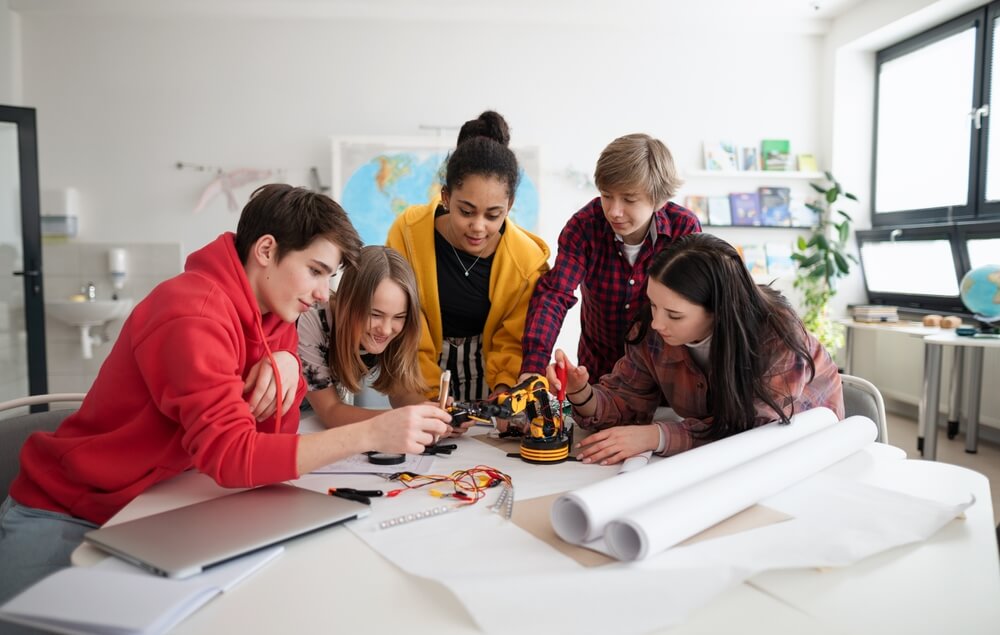
Halfpoint/Shutterstock.com
Eventually, kids will outgrow visual programming and express a desire to learn “real coding.” That’s when you’ll know it’s time to accelerate the learning process with some more formal coding instruction. At this point, you’ll want to consider the options available for teaching kids to code using an actual programming language.
Online Coding Schools
For a kid who’s already interested in computers, the idea of taking online classes to learn to code is a no-brainer. Fortunately, there are many different online platforms with coding classes to choose from here. Some popular examples include Udemy, Tynker, and edX.
While no one coding program is objectively better than another, there may be certain aspects of a platform that work better for your family. Prior to making a decision, we recommend looking at reviews and experimenting with the coding course by signing up for a free trial if possible.
Private Coding Lessons
Most online coding courses are self-paced and provide the resources for children to essentially teach themselves. If this approach aligns with your child’s learning style, then it may be the ideal route. Not all kids learn this way, though, and some may need more one-on-one instruction and support than others.
This is where private coding lessons can bridge the gap. Private coding lessons are also available online and usually rely on teleconferencing software like Zoom. Depending on where you live, you may also be able to find a private coding tutor who will provide in-person instruction.
The downside of private coding instruction is that it can be quite expensive. Plus, there is the obstacle of scheduling lessons around your family’s calendar as well as the tutor’s.
The Standard School Curriculum
As the demand for coding increases, schools across the globe are recognizing the need for widespread coding instruction. That’s why many public and private schools have adopted a coding curriculum for their students. While some of these schools devote a specific class to coding, such as AP Computer Science Principles for serious learners, others integrate it into various subjects across the curriculum. Some elementary and middle schools have even started using Minecraft Education to teach various subjects, including coding.
If you think your child could benefit from formal coding instruction in the traditional classroom setting, contact the school’s administration for more information about how teachers address coding. Depending on your child’s specific goals, you may need to shop around for a school with a strong coding curriculum and dedicated teacher training for computer science and teaching kids coding.
What Is the Best Programming Language for Kids?
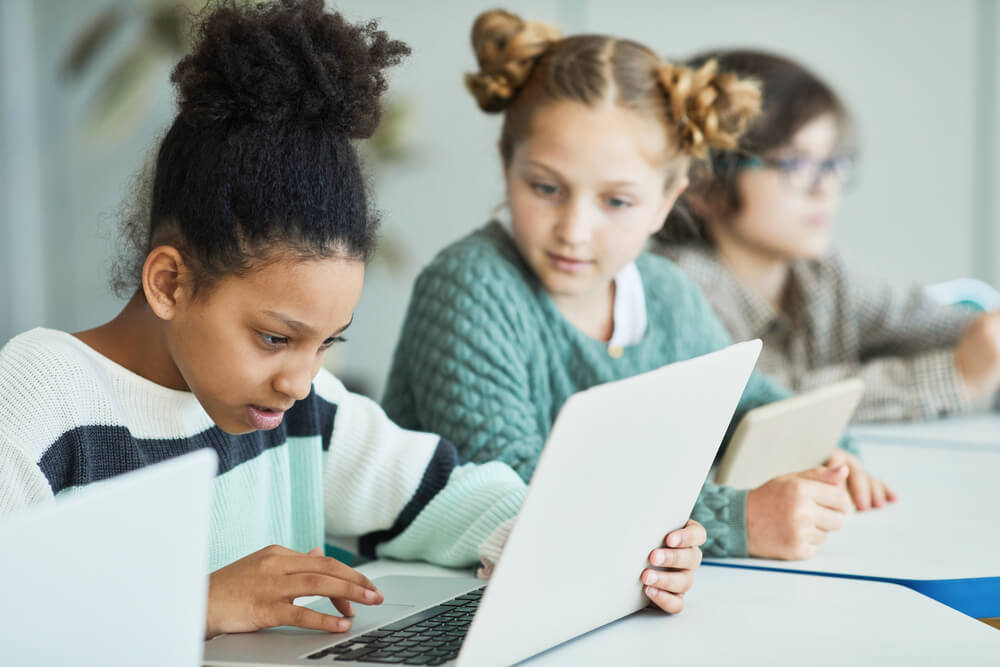
SeventyFour/Shutterstock.com
Whether you decide to introduce a real programming language early on or down the line, Python is the best language to use for kids. That’s because it’s both extremely easy to learn and very popular with tech companies.
Here are some resources to get you and your child started on the journey to learn Python:
- Tynker’s Introduction to Python – This introductory course is recommended for older kids ages 12+ and costs $15/month. It includes well over 100 different activities, including interactive games and puzzles.
- Udemy- Teach Your Kids to Code: Learn Python at Any Age! –This course walks kids through the process of learning Python by using a project-based approach. Children learn to create graphics and games in short, accessible modules. There is a one-time fee of $29.99.
- Python for Kids: A Playful Introduction to Programming—Written by Jason R. Briggs, this book makes a great print resource for introducing kids to Python. You can get the paperback for around $15 on Amazon.
Get Involved in Your Child’s Future!
Teaching your kid to code is not only an investment in his or her future. It’s also a great way to get involved in your child’s learning and development. If you’re tech-minded yourself (or just willing to learn!), you can even participate in coding activities alongside your child. In this way, learning to program can be a bonding experience with the extra benefit of an ROI!
And as they say, the more the merrier! Get your kids’ friends involved in the experience by sharing this article with their parents. Learning to code can be a fun social activity for children to explore together!
FAQs
What is coding for kids?
Coding for kids teaches children of all ages how to write software programs. There are multiple programming languages that they can learn to set them up for a professional career. For example, they could become a game designer, mobile app developer, website creator, and more when they grow older.
Why should kids learn to code?
As technology advances further, especially with Artificial Intelligence, it’s more important than ever for our children to have a comprehensive computer science education, which includes learning how to code. It can set them up for professional success and help them understand how technology works.
Why is computer science important for kids?
Our children are growing up in a more tech-focused world than we did. Understanding the importance of teaching our kids information systems and computer science is the first step in helping your child reach their full potential in a digital world. Whether they try a simple drag-and-drop programming course at a young age or go on to earn a degree in computer science, coding is a skill necessary in the real world.
The picture on the front page: Gorodenkoff//Shutterstock.com
Проверьте электронный ящик
















